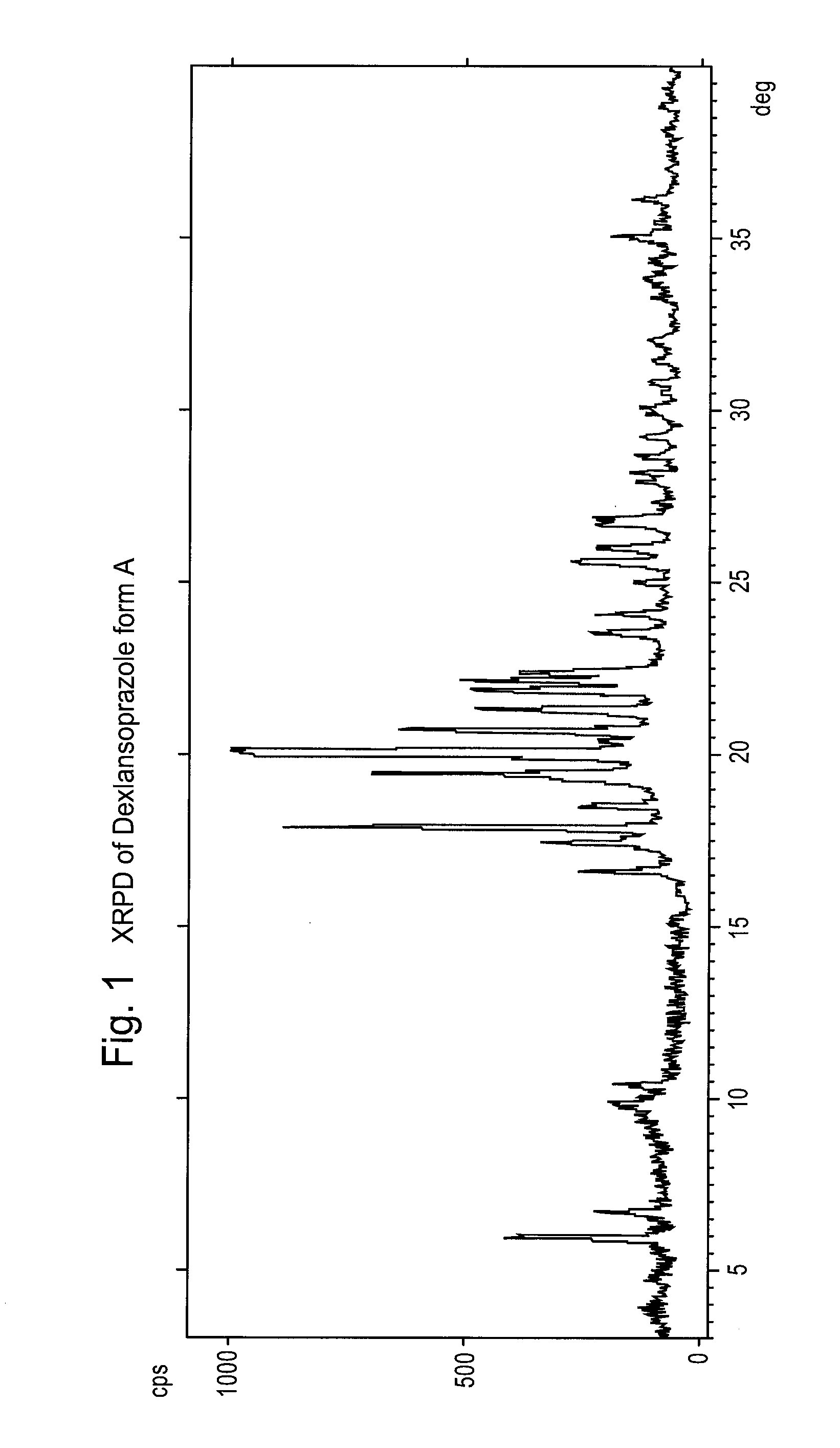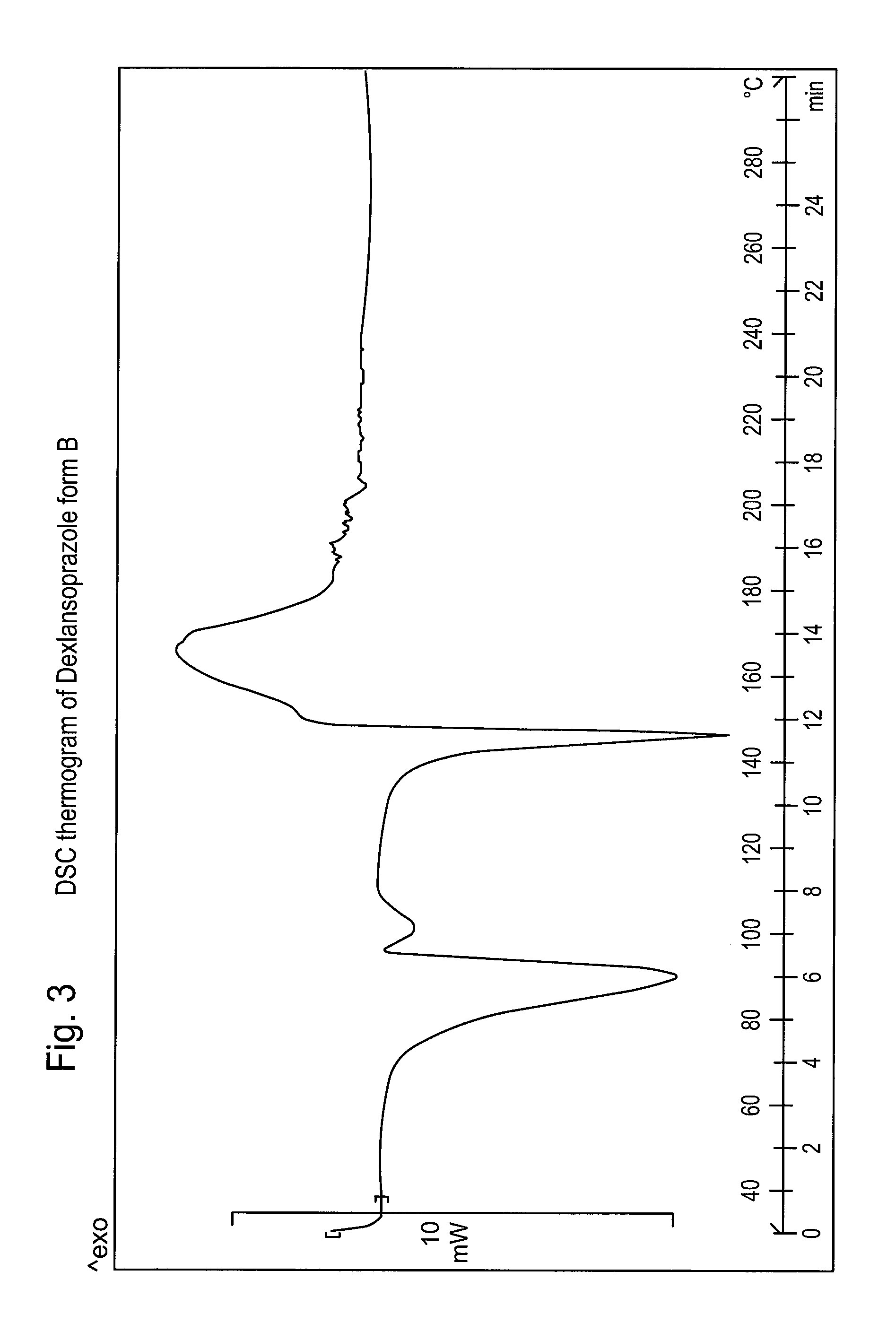Crystalline forms of dexlansoprazole
a technology of dexlansoprazole and crystalline forms, applied in the field of crystalline forms of dexlansoprazole, can solve the problems of poor industrial application applicability, low process yield, and inability to crystalline form
- Summary
- Abstract
- Description
- Claims
- Application Information
AI Technical Summary
Problems solved by technology
Method used
Image
Examples
example 1
Preparation of Dexlansoprazole, Form A
[0088]1.6 g of anhydrous Dexlansoprazole is suspended in 5 ml of trifluoroethanol, and the dispersion is heated to 35-40° C. until completely dissolved. The dispersion is then rapidly cooled to 0° C., and a solid precipitates. The solid, which is 99.7% pure, is recovered by filtration through a Bückner filter.
[0089]XRPD: Main peaks at 6.0, 6.7, 16.6, 17.4, 17.9, 18.5, 19.4, 20.0, 20.7, 21.3, 21.8 and 22.1±0.2° in 2θ.
[0090]H1-NMR (in DMSO): d (1H), 8.27 ppm; m (2H), 7.6 ppm; dd (2H), 7.27-7.30 ppm; d (1H), 7.07 ppm; broad t (2H), 6.05 ppm; q (2H), 4.84-4.92 ppm; q (2H), 4.72-4.84 ppm; m (4H), 3.75-3.95 ppm; s (3H). 2.16 ppm.
example 2
Preparation of Dexlansoprazole, Form B
[0091]2.0 g of anhydrous Dexlansoprazole is dispersed in 5 ml of acetonitrile and 3 ml of trifluoroethanol. The dispersion is heated to 35° C. until completely dissolved. The solution is cooled slowly to about 0° C., and a pale solid precipitates. The dispersion is filtered through a Bückner filter to recover the solid, which is 99.8% pure.
[0092]XRPD: Main peaks at 7.8, 8.3, 9.8, 11.1, 13.3, 15.2, 16.9, 17.4, 19.1, 19.5, 21.8, 22.1 and 23.5±0.2° in 2θ.
[0093]The product shows a DSC thermogram as reported in FIG. 3.
[0094]H1-NMR (in DMSO): d (1H), 8.27 ppm; m (2H), 7.6 ppm; dd (2H), 7.27-7.30 ppm; d (1H), 7.07 ppm; broad t (0.5H), 6.05 ppm; q (2H), 4.84-4.92 ppm; q (2H), 4.72-4.84 ppm; m (1H), 3.75-3.95 ppm; s (3H). 2.16 ppm.
example 3
Preparation of Dexlansoprazole, Form C
[0095]Dexlansoprazole form B is stove-dried at 40-45° C. at low pressure for about 10 h. The solid recovered is 99.9% pure.
[0096]XRPD: Main peaks at 8.1, 10.3, 10.8, 11.9, 14.7, 15.1, 16.6, 18.1, 19.1, 21.4 and 23.0±0.2° in 2θ.
[0097]H1-NMR (in DMSO): d (1H), 8.27 ppm; m (2H), 7.6 ppm; dd (2H), 7.27-7.30 ppm; d (1H), 7.07 ppm; q (2H), 4.84-4.92 ppm; q (2H), 4.72-4.84 ppm; s (3H). 2.16 ppm.
PUM
| Property | Measurement | Unit |
|---|---|---|
| water content | aaaaa | aaaaa |
| water content | aaaaa | aaaaa |
| temperature | aaaaa | aaaaa |
Abstract
Description
Claims
Application Information
 Login to View More
Login to View More - R&D
- Intellectual Property
- Life Sciences
- Materials
- Tech Scout
- Unparalleled Data Quality
- Higher Quality Content
- 60% Fewer Hallucinations
Browse by: Latest US Patents, China's latest patents, Technical Efficacy Thesaurus, Application Domain, Technology Topic, Popular Technical Reports.
© 2025 PatSnap. All rights reserved.Legal|Privacy policy|Modern Slavery Act Transparency Statement|Sitemap|About US| Contact US: help@patsnap.com



